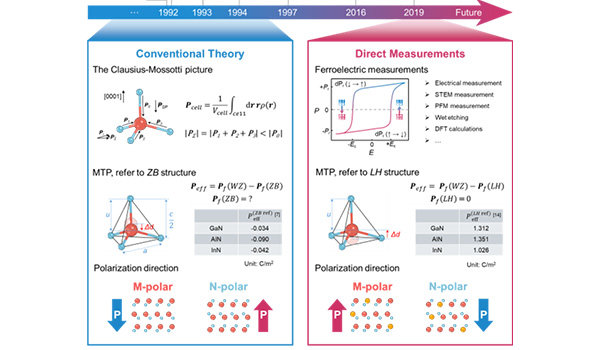

 News and Information
News and Information Knowledge Column
Knowledge ColumnGallium nitride (GaN) is the second most commonly used semiconductor material after silicon. Its phySICal properties and applications are based on the polarization generated by its centrosymmetric Waltz lattice. Recent direct experimental findings have shown some directions that contradict conventional expectations, and significant residual polarization levels have also attracted attention.
This significant inconsistency highlights the need for a rigorous review and enhancement of existing methods to incorporate these new findings into existing knowledge frameworks, thereby reducing the risk of misunderstandings and misinterpretations in this rapidly developing field.
In recent years, research on group III nitrides (GaN, AlN, InN, and related alloys) has been very active in various fields such as electronics, optoelectronics, piezoelectric electronics, quantum photonics, and clean energy. Group III nitrides are characterized by their stable Waltz stone phase without symmetrical centers.
Within its structure, an electric dipole is formed due to the unequal parts of the other three bonds compared to the parts along the c-axis. This dipole is crucial in defining the optical and electrical properties of Waltz stone nitrides, resulting in significant spontaneous and piezoelectric polarization along the c-direction.
Modern Polarization Theory (MTP)
Modern polarization theory (MTP) provides quantitative explanations and modeling for polarization phenomena in nitride heterostructures. Using the zinc pyroxene (ZB) structure as a reference, Bernardini et al. first calculated the polarization constant in group III nitrides. The achievements of MTP have attracted widespread attention worldwide and have been highly valued in textbooks, becoming a model for successfully combining theoretical concepts with experimental results.
However, recently various research groups have conducted experimental measurements on the polarization of Waltz nitride semiconductors. The introduction of rare earth elements (ferroelectric materials) into the Waltz structure significantly reduces the energy barrier for polarity switching, thus achieving experimental determination of spontaneous polarization in Waltz semiconductor for the first time.
Surprisingly, the measured spontaneous polarization direction is opposite to the MTP prediction, and its magnitude is even larger, reaching an order of magnitude. In addition, these results were further validated by scanning transmission electron microscopy (STEM), piezoelectric response force microscopy (PFM), wet etching, and density functional theory (DFT) calculations.
These fundamental differences significantly challenge theoretical frameworks and device development, profoundly disrupting our fundamental understanding of polarization in these materials. Therefore, it is necessary to re evaluate the theoretical framework of polarization phenomena in Waltz stone semiconductors.

Polarization direct measurement based on layered hexagonal reference
This study aims to critically analyze polarization phenomena in Waltz stone semiconductors to clarify potential misunderstandings in existing theories and experiments. Another method is to use a layered hexagonal structure as a reference.
In each unit cell, four atoms form a hexagonal Bravais lattice, defining the Waltz structure. Throughout history, tetrahedra have been a common reference point for a clear understanding of polarization in the structure of Waltz stones. The polarization vectors in a perfect tetrahedron cancel each other out.
In the Waltz structure of III nitrides, the core atoms are not entirely located at the tetrahedral center. This will result in polarization along the c-axis, and this value is not zero, sometimes referred to as spontaneous polarization. In the same plane, the polarization vector changes under uniform strain, resulting in polarization along the c-direction - also known as piezoelectric polarization.
As shown on the right side of Figure 1, the results of the direct measurement experiment do not match the expectations of traditional theory. The typical reference structure suggested by researchers is a layered hexagonal structure.
This new model has unique advantages because the calculations based on the layered hexagonal structure are more consistent with experimental results. This indicates that using a layered hexagonal reference will help to more accurately and comprehensively understand the polarization in Waltz stone nitrides.
These advances require a comprehensive review of polarization in Waltz stone semiconductors and emphasize the applicability of using layered hexagonal structures as standard references.
Impact and Future Direction
A new perspective on polarization requires us to re-examine important events in nitride devices, including the behavior of two-dimensional carrier gases (2DCGs) and the influence of internal electric fields. The exploration of polarization effects in relaxed heterostructures and the possibility of non electrical characterization methods depend on further research.
This new framework also emphasizes the important role of piezoelectric effect in generating two-dimensional electron gases (2DEGs), which may be more significant than the role of spontaneous polarization previously thought. In addition, the stability and toughness of 2DEGs in nitride systems are also being further studied.
Conclusion
The latest progress in polarization measurement in Waltz stone nitrides requires a fundamental shift in our understanding of this phenomenon. This transformation will not only strengthen the theoretical framework, but also improve the design principles and functions of nitride based devices, paving the way for future innovation in this field.
Fushite Technology focuses on the field of power devices, providing customers with power devices such as IGBT and IPM modules, as well as MCU and touch chips. It is an electronic component supplier and solution provider with core technology.